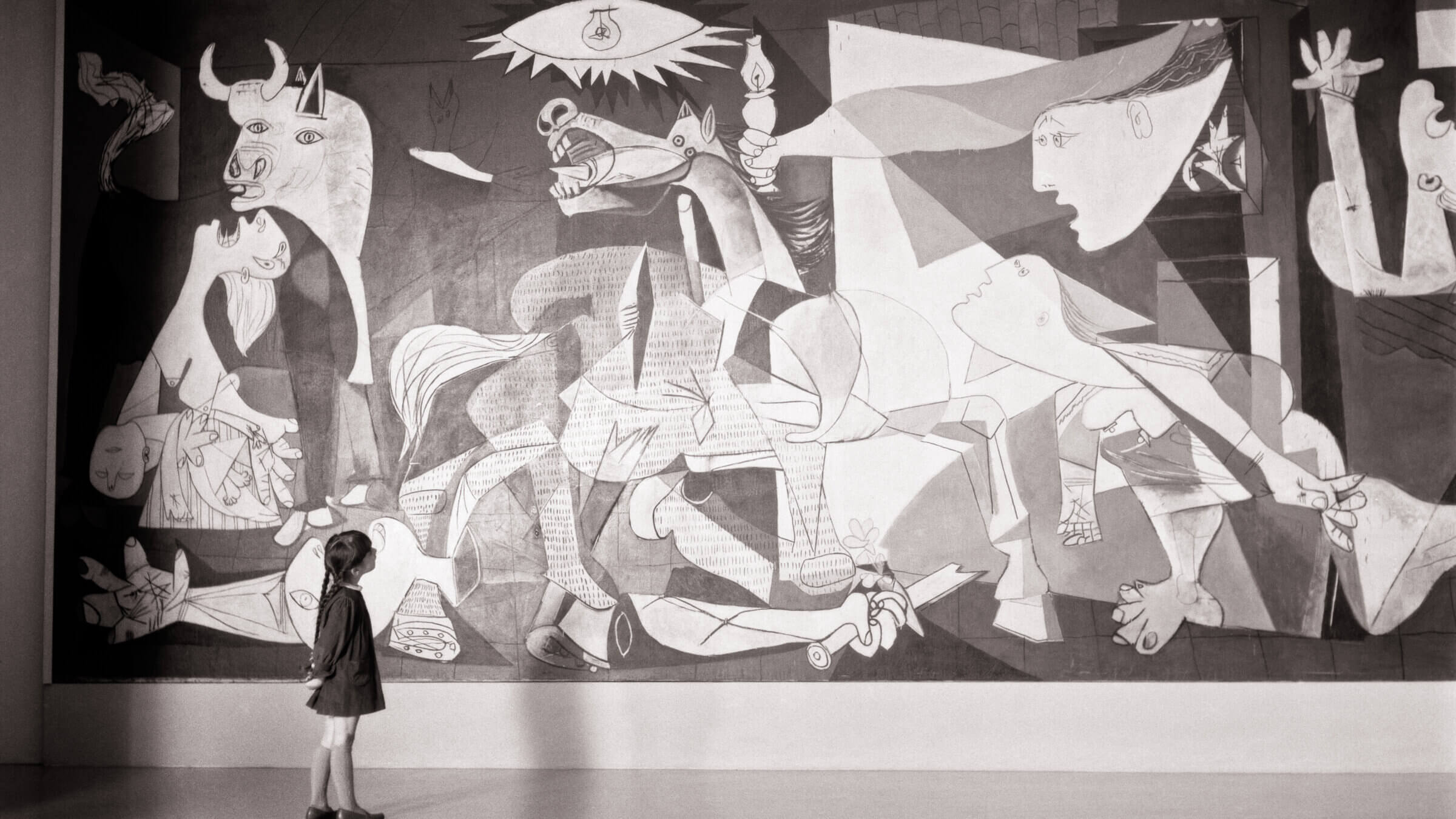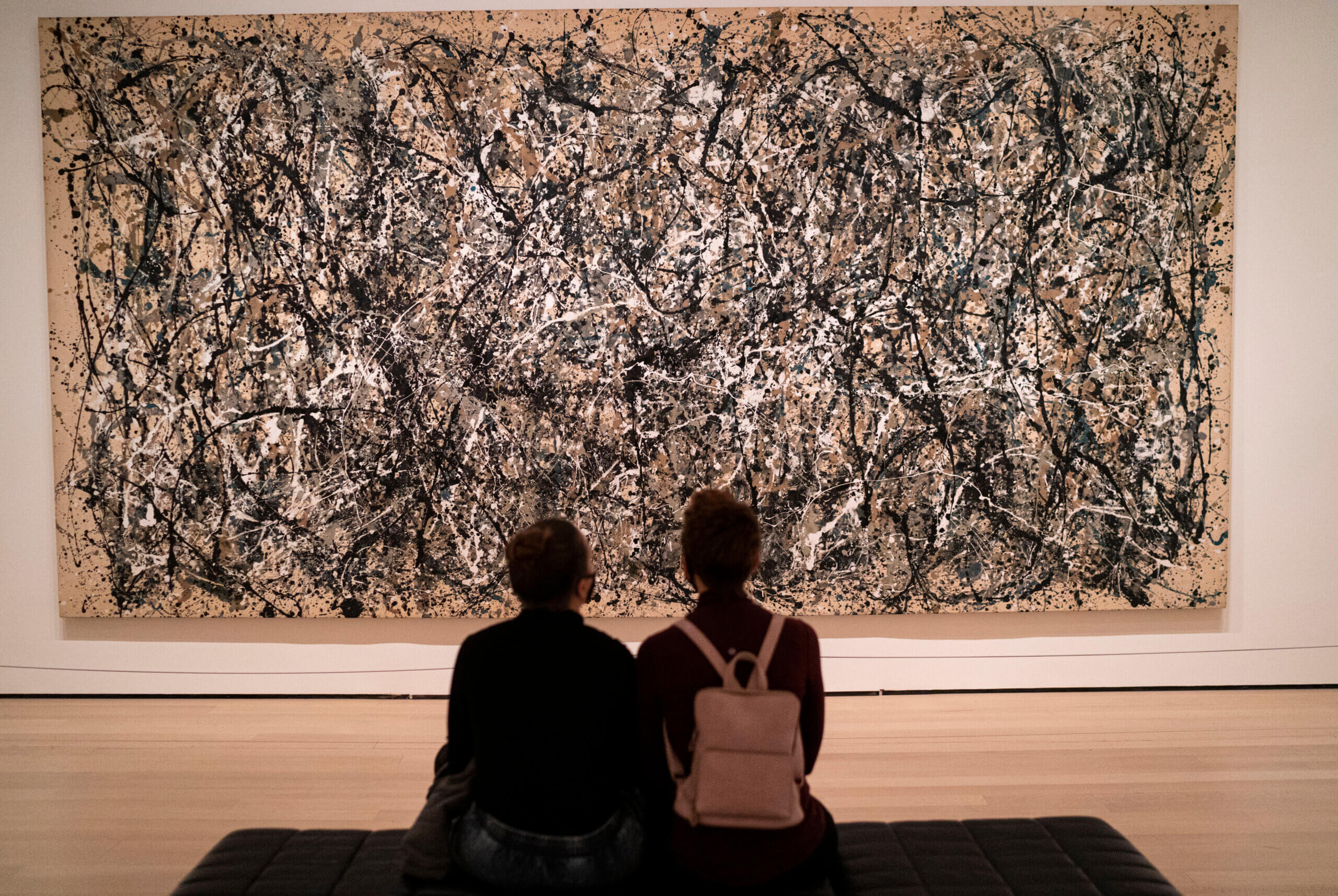Whose art is it anyway? Inside the cultural battle between pro-Israel and pro-Palestinian protesters
Since the war broke out, debate has raged over the political meaning of art
S

Does this child see the anti-war in Picasso’s Guernica or something else entirely? Courtesy of Getty Images
By Mira Fox
At a Seder at Yale’s protest encampment this spring, students put their arms around each other and swayed. “If we build this world from love, then God will build this world from love,” they sang, gathered around a sheet painted as a Seder table.
The words are lyrics from Olam Chesed Yibaneh, a Hebrew folk song composed by Rabbi Menachem Creditor, who wrote it for his oldest child’s naming ceremony in 2002. But despite the fact that Creditor himself has a long history of progressive activism, he was irate to see his tune sung at a pro-Palestinian protest. In an interview with the Forward, he said that the students were “misappropriating its message of love and support for Israel,” using his song about peace to obscure the antisemitism that he believes lies at the heart of the pro-Palestinian protests.
Yale Jews for Ceasefire, the group hosting the Seder, in a statement responding to Creditor, said that, for them, the song imagines “a future where Israelis and Palestinians can live in peace, in a world built from love.” They were undeterred by Creditor’s disagreement with their cause, saying that they “respect” his own interpretation of the song, but reaffirming their embrace of Olam Chesed Yibaneh.
Art — paintings, music, books, movies — has become part of the culture war swirling around Israel and Gaza that has been gaining steam steadily since Hamas’ attack on Oct. 7 and Israel’s subsequent response. Concerts have been canceled and art has been damaged by protesters, all part of a battle over the political meaning and value of art.
Art has always had an uneasy relationship with political messaging, and utility. Does it hinge on the art itself or the artist’s intentions? Or something else entirely?
Is art’s political message ever clear?

Plenty of art is overtly political, aiming for a clear message. It’s hard to miss the point of the piece in this year’s Whitney Biennial that spelled out “Free Palestine” in blinking lights — though, in fact, it took some time for the museum to notice. The guerilla artist Banksy has painted graffiti in Bethlehem and Ramallah, images of doves in military vests and a militant in a kaffiyeh hurling a bouquet; these pieces too, by virtue of both their placement and content, seem to make a clear political statement.
But often, it’s not so obvious. Pablo Picasso created numerous anti-war paintings, including the masterpiece Guernica; earlier this year, protesters brought Palestinian flags to demonstrate in front of the piece, an attempt to underline its message, and another artist used its imagery in her own work about the horrors of Hamas’ Oct. 7 attack.
Yet even a piece like Guernica, today perhaps best known for its anti-fascist message, might not seem like it’s about war at all if you haven’t heard about it or read the helpful wall text. The cubist work is full of horses and faces, but also abstract shapes and shadows, a disembodied arm holding a lantern. Indeed, in its time, Picasso was criticized for the work’s ambiguity.
The artists’ identity
Artists can’t always control the impact of their work, but their identity can still, sometimes, shape its message. When the 2017 Whitney Biennial featured a painting of a mutilated Emmett Till in an open coffin, what the artist intended as an indictment of anti-Black racism was seen as emblematic of it; protesters saw a white artist co-opting and making a spectacle out of Black pain. The fact that this wasn’t what the artist intended doesn’t change the message that audiences took away from it.
This case is not unlike that of the Jewish reggae artist Matisyahu, who writes songs about peace. His anthem “One Day” is, in a literal sense, clearly a song about peace for all. Nevertheless, the artist has had numerous concerts canceled since the war broke out; some audiences today interpret his music as supporting war since he’s a Jewish, Zionist man who performed at the March for Israel in Washington, D.C., this past November.
For the seemingly avid users of a list of authors’ stances on Israel, which supports writers it has identified as pro-Palestinian and discourages people from reading books by those it has deemed Zionists, the actual content has nothing to do with their value; that’s defined entirely by their authors’ identities and social media posts.
 Jackson Pollock’s One: Number 31, 1950. Courtesy of Getty Images
Jackson Pollock’s One: Number 31, 1950. Courtesy of Getty ImagesWho gets to say what any given work of art means has been debated throughout history. The ideas evoked by staring at Jackson Pollock’s splatter paintings, for example, are as abstract as the pieces themselves. Many people walking into a gallery don’t know that Pollock was part of the abstract expressionism movement or steeped in Jungian psychoanalysis, nor do they apply that lens to attempt to understand his art.
But you don’t need that information to connect to the power, color and movement of his work, just like it’s possible to connect to Taylor Swift’s breakup ballads without being a Swiftie steeped in the pop star’s dating history. I grew up singing classical choral music, almost all of which was written for the church, and I still find the requiems and masses deeply moving despite the lyrics praising Jesus. Am I engaging with this music wrong?
Seeking clarity in abstraction
Nevertheless, people seem hungry for instructions about which concerts to attend and which to protest, which books to read and which to decry, what art is good — morally and politically speaking — and which is bad. Since Oct. 7, lists have been circulating, telling anyone, depending what political circle they’re in, which celebrities or influencers, writers or actors, are canceled. People want a simple, definite answer. That’s easier to get if you’re willing to boil the art itself down to its creators’ opinions. But that’s against the nature of art.
“While there is one text for Hamlet, every person who sees the play sees a different Hamlet. Moreover, every time you see Hamlet, it is different,” wrote New York Magazine’s art critic Jerry Saltz in a 2018 piece about how to be an artist. “This is the case with almost all good art. It is always changing, and every time you see it anew, you think, How could I have missed that before? Now I finally see! Until the next time it rearranges your thinking.”
Perhaps it’s easier to accept the mutability of a work when the artist is dead, unavailable to dictate what it “really” means, their own lives far enough removed from our own that we can encounter their work directly. But today, many artists are actively attempting to use their art for political purposes, and tell the audience what it’s supposed to stand for.
Last month, numerous authors withdrew their work from consideration for the PEN America Literary Awards; they said the organization had not done enough to protect Palestinian writers.
While they succeeded at making a political statement — the awards were canceled, the prize money donated — that impact isn’t necessarily about the novels themselves, but instead about book sales and fanfare. It may earn those authors brownie points from the pro-Palestinian books list and praise from certain corners of the internet, but it isn’t directly related to the artistry of their work. If there is any related political impact, it has to do with proving that it’s more profitable for authors to make statements supporting Palestinians, perhaps encouraging more authors to do the same. But the contents of the books themselves are unchanged by their authors’ personal political action; they remain good, or not, and anyone can declare them best of the year — and, indeed, the titles remained on PEN America’s public list of finalists.
“The art scene often confuses art’s soft power with the power to wield public sentiment and direct public action,” wrote Seph Rodney, the former senior critic at Hyperallergic, in a piece about the debate surrounding a new public art installation which adds a female figure to the statuary at the New York State Supreme Court. Action, he points out, is “something that humans do, not inanimate objects.” Artists can take political action but their art, by itself, cannot.
Still, their art can have a political impact. It can inspire, it can cause people to question new things or reach a new understanding through empathy or emotion. And art can empower artists to have a political impact — after all, the PEN America boycott would never have had any impact at all had PEN not given the artists a public platform. It’s a potent, convoluted mix of forces.
But art, still, has a life of its own; the artist can’t control it any more than any individual observer. You can, of course, show people new interpretations, encourage them to look more deeply or from another perspective. You can reject someone else’s interpretation of a piece, or change your own. But ultimately, you can’t control what anyone else thinks art means. A song designed to be pro-Israel can become an anthem for pro-Palestinian protesters. And maybe there’s not really any contradiction there, after all.

Mira Fox is a reporter at the Forward. Get in touch at fox@forward.com or on Twitter @miraefox.
At the Forward, our Vision and Mission articulate the change we want to see in the world, and how we can help make it happen. Our Values describe the essential pieces of who we are and how we operate. After 120+ years spent serving the Jewish community, and with our new global reach and purely digital focus, there are a lot of stakeholders who rightfully feel a deep connection to the Forward and what we do. The articulation of our Vision, Mission, and Values is informed by that history and those relationships.
Vision
The Forward envisions a vibrant, connected global Jewish community informed by our shared history and committed to justice, compassion, truth and our collective responsibility to bridge our divides.
Mission
The Forward is the most significant Jewish voice in American journalism. Our outstanding reporting on cultural, social and political issues inspires readers of all ages and animates conversation across generations and different segments of our community. Our English and Yiddish platforms build on a century-old legacy maintained in our archives and lead to a deeper understanding of what it means to be Jewish in the 21st century.
Values
Integrity: We provide fair and full reporting in the highest tradition of public-service journalism, a cornerstone of resilient democracy. Through our work, we help build the foundation for a just, open, pluralistic society.

No comments:
Post a Comment